Hardy annuals provide a colorful garden with annual flowers, quickly and cheaply through the wise use of flower seeds.
By planting these inexpensive seeds properly and tending to them carefully, you will be rewarded with beautiful early blooms lasting in most cases, all Summer.
The most popular hardy annuals mentioned are only a few of the 100’s of varieties running the gamut of colors, sizes, and shapes.
The time to start your garden is NOW – planning or planting.
When and How To Plant Hardy Annuals
Tender and Hardy Annuals The Two Types
Annuals are divided into two types on the basis of their reaction to cold:
- Hardy Annuals
- Tender Annuals
Although these annuals may be divided according to their use. Generally, the taller annuals are used in the back of the border, the medium-sized for the middle border and the dwarf types for edging.
Hardy annuals can stand frost and be planted early. In the South and on the West Coast, they are often planted in the Fall.
Some of the more popular hardy annual varieties include:
- Sweet Peas
- Larkspur
- Snapdragons – Antirrhinum majus
- Pansies
- Violas
- Alyssum
- Poppies
- Phlox
- Pinks
- Calendula
- Candytuft
 Tender Annuals love hot weather and should not be planted until the soil warms up and the danger of frost passes.
Tender Annuals love hot weather and should not be planted until the soil warms up and the danger of frost passes.
These include:
- Ageratum
- Asters
- Celosia
- Marigolds
- Petunia
- Zinnia
- Morning Glories
Early planting of these annuals will not speed up bloom unless they are started indoors where it is warm.
Raise annuals from seed or purchase young bedding plants from the local nursery, or big box garden centers.
Growing plants from seed is one of the most exhilarating and educational experiences in gardening. But, it can also be most exasperating.
When you plant seeds and they don’t sprout, you not only are out the cost of the seed and your labor, but you lose valuable time and the season doesn’t wait.
Start these annuals in flats:
- Petunias
- Marigolds
- Snapdragons
- Pansies
These annuals will bloom quicker and grow better if planted in the open and never transplanted.
- Sweet Peas
- Zinnias
- Alyssum
Planting directly in the flower bed has, in the past, been discouraging.
Low humidity frequently causes the soil to dry rapidly. Seeds need a constantly moist or wet soil surface for good germination.
Unless the flower bed has sufficient moisture during this critical period, the tiny plants will die.
- Prepare the flower bed by working in a deep layer of composted humus.
- After smoothing the surface and it has been leveled, scatter seeds over the surface and lightly rake in.
- Tamp the soil with the back of the hoe or firm by watering gently with the spray nozzle attached to a hose.
TIP: Stretch a plastic film over the seed bed, anchoring it at the corners with rocks or stakes. Remove the plastic when the seedlings emerge. Water-daily until the first true leaves appear.
Then thin out the plants to the recommended spacing.
How To Plant Seeds Indoors
- The flat is filled with a sifted mixture of garden soil and planter mix.
- The planting mix is compacted with a brick to make a firm seed bed.
- The flat is watered carefully with a syringe to prevent washing out the seed.
- The flat is covered with wet burlap. A pane of glass or plastic film may also be used.
Annuals need exposure to full sun and this is the most important consideration in choosing the location of the flower bed.
It should be at least 3’ feet wide to make a mass display possible. But no more than 6’ feet wide so the flowers do not lose their individual effect.
The length doesn’t matter, but be sure not to lay out an area greater than can be easily managed.
In the Spring, when months of inactivity and the cool weather invite exercise, it is easy to plan a garden that quickly degenerates into a weed patch.
As the weather warms other activities clamor for attention and soon hot weather demands more time for rest and relaxation.
The best flower beds are generally those with a definite color plan and only a few kinds of flowers in masses or groups.
However, many people achieve equally satisfactory results by seemingly random planting.
Transplanting Seedlings
Seeds are commonly started in large flats.
- In watering, avoid splashing. Apply a fine spray so the seed is neither washed out nor the newly transplanted seedlings damaged, even slightly.
- When the first true leaves appear, thin out the seedlings to the proper number.
- After seedlings reach about 2” inches they are then transplanted to the flower garden.
- You may be tempted at times to save your own seed from an especially sturdy or attractive plant.
- Such seed may not come true, especially from the horticultural varieties of annuals.
- When you buy seed from nurseryman, you can be sure of its performance since reputations are at stake.
Edging Annuals
Let’s look at some of the more popular Hardy Annuals. For the sake of easy reference, we’ve divided them into:
- Edging Annuals
- Middle Border Annuals
- Back Border Annuals
- Miscellaneous Annuals
The Edging Annuals
- Alyssum
- Pansies
- Violas
- Pinks
- Dwarf varieties of Phlox
These annuals are used extensively for the purpose of edging because of their relatively small height.
Alyssum
There have been many new Alyssum varieties developed. Just a few years ago the only color available was white. Now you’ll find Alyssum in deep rose, pink and violet.
Alyssum makes a good ground cover to hide fading bulb foliage.
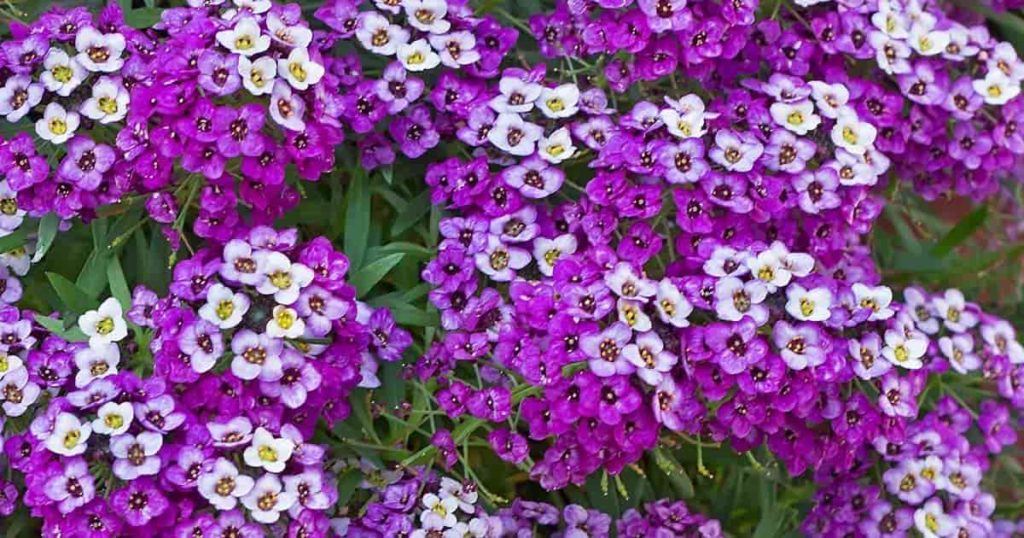 Alyssum is a very free-flowering plant that comes into bloom within 5 to 6 weeks after planting. The blooming season continues until frost in all but the warmest areas, where it dies in the summer heat of Summer.
Alyssum is a very free-flowering plant that comes into bloom within 5 to 6 weeks after planting. The blooming season continues until frost in all but the warmest areas, where it dies in the summer heat of Summer.
It is the most popular plant for edging and for a ground cover to hide the fading foliage of Spring bulbs.
A low-growing, spreading plant, with numerous flower clusters produce a solid mass of color with a mild fragrance.
Easy-to-grow Alyssum can be planted anytime, even in the snow. It self-sows (replants itself yearly), and you rarely have to plant it again. This makes Alyssum especially convenient in a rock garden.
Broadcast (scatter) the seeds thickly on the surface – they do not need to be covered.
If you buy plants, or start them early in flats, the plants should be set out as soon as possible, about 6” inches apart.
Details on Growing and Care Of Alyssum Flowers
Pansies and Violas
Pansies and Violas both are derived from the wild form known as “Johnny Jump-up.”
This native of Europe, still being grown, has been used in gardens for centuries.
Pansies and Violas should be planted 6” inches apart and require 10 to 14 days to germinate from seed.
The plants, which grow only 4” to 6” inches tall, bloom in 2 to 3 months producing relatively large flowers.
Cool temperatures and plenty of moisture are necessary for maximum bloom.
The soil should also be enriched with quantities of composted humus.
Plants grown in the shade will usually bloom longer, but those grown in the sun bloom earlier.
Violas
Violas have smaller flowers than Pansies and usually come in solid colors, e.g., blue, yellow, violet-blue, red and snow-white.
They also produce more bloom and often last longer than Pansies.
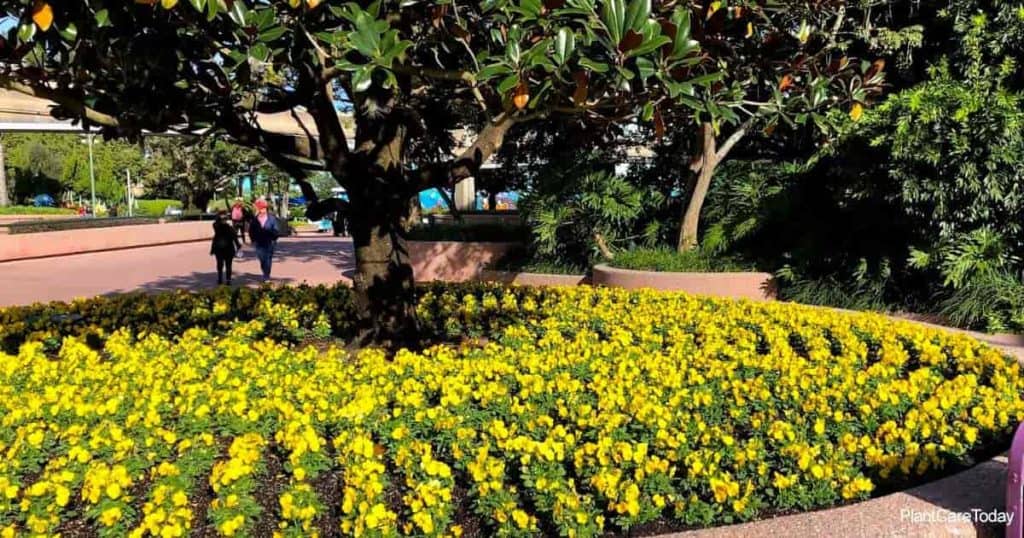 Violas are most used where masses of single colors are needed in beds, borders and edgings, and recommended where color is more important than the size of individual blooms.
Violas are most used where masses of single colors are needed in beds, borders and edgings, and recommended where color is more important than the size of individual blooms.
They are superb accompaniments to Spring bulbs, and as a ground cover under Spring flowering shrubs and trees (where they can be used in contrasting colors for emphasis).
Details on Growing and Care of Viola Plants
Pansies
No matter what you do to a Shetland pony, he won’t grow up to be a draft horse. Similarly, unless you start with a giant-flowered strain you will be disappointed in the size of bloom.
Color (e.g., white, yellow, blue, violet, ruby, apricot and bi-colors), form and length of stem are also determined first by the breeding, then by the cultural care.
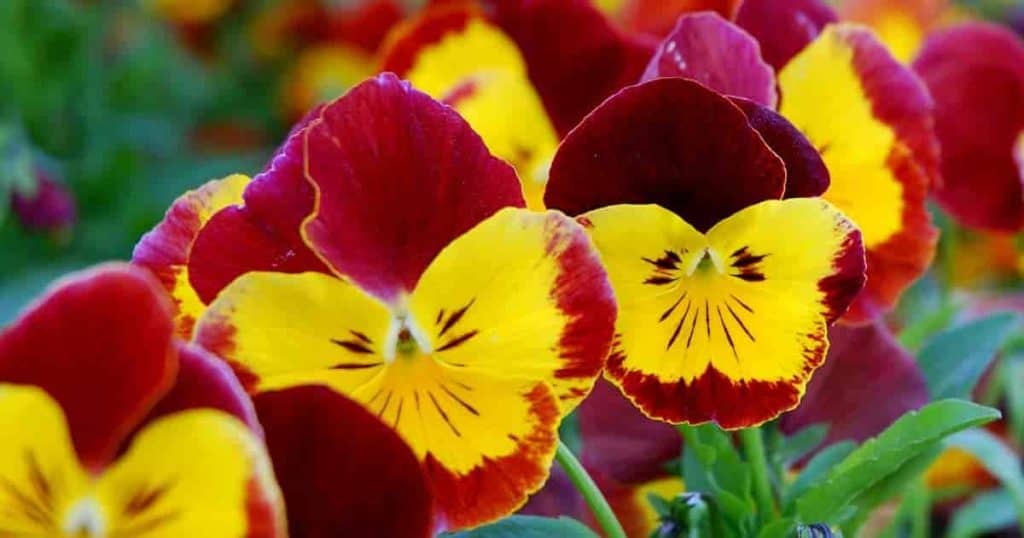 The beds should first be prepared with liberal amounts of composted humus and the seed planted 2 to 3 weeks later.
The beds should first be prepared with liberal amounts of composted humus and the seed planted 2 to 3 weeks later.
If you grew Pansies there before, you may want to consider sterilizing the soil otherwise the previously planted Pansies may reappear.
- For early Spring bloom, plant in August
- For Summer flowers, plant in early Spring
Field- grown plants in baskets or greenhouse-grown plants in flats can also be purchased and set out suffice if grown from seed.
Fertilize every 2 weeks with a rich organic fertilizer whether the Pansies are grown from seed or transplanted.
Also, for all Pansies, mulch the bed with any coarse organic material, to control weeds and conserve water.
It is not true that Pansy blooms must be picked off, and much time can be saved by forgetting this old adage.
Details on Growing and Care of the Pansy Flower
Annual Phlox
Annual Phlox (Phlox drummondii), one of the most brilliant-colored of all flowers, comes in dwarf, medium and tall sizes and scarlet, crimson, yellow, pink and white shades.
The dwarf varieties, only 6” to 8” inches tall, are popularly used as edging.
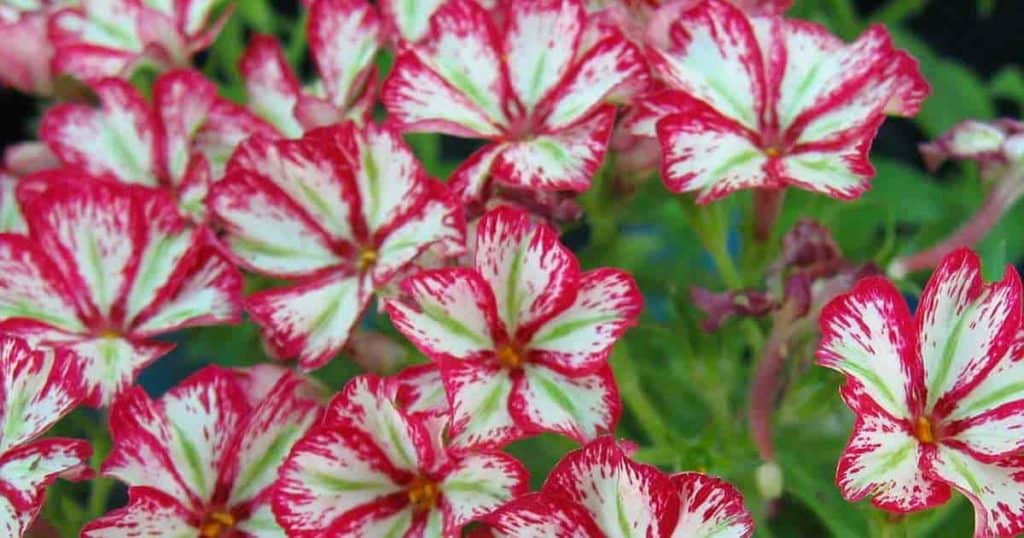 Phlox can be planted early, or at any time during the Fall or Spring (until about the 1st of June). Blooms ordinarily will appear within 60 days to 6 weeks if the weather is warm.
Phlox can be planted early, or at any time during the Fall or Spring (until about the 1st of June). Blooms ordinarily will appear within 60 days to 6 weeks if the weather is warm.
In most climates, Fall-planted seed will bloom in early Spring and, if cut back, will continue to bloom throughout the Summer. In mild climates, the Fall-planted Phlox will bloom during the Winter.
Seed should be broadcast and covered with ¼” inch of soil. The seedlings should then be thinned to 4” inches apart for the dwarf varieties and 8” inches apart for the tall varieties.
Details on Growing and Care of Annual Phlox
Pinks (Dianthus)
These flowers are so named because of the fringed or ⅛” pinked margin of the petals and not because of their color as so many believe.
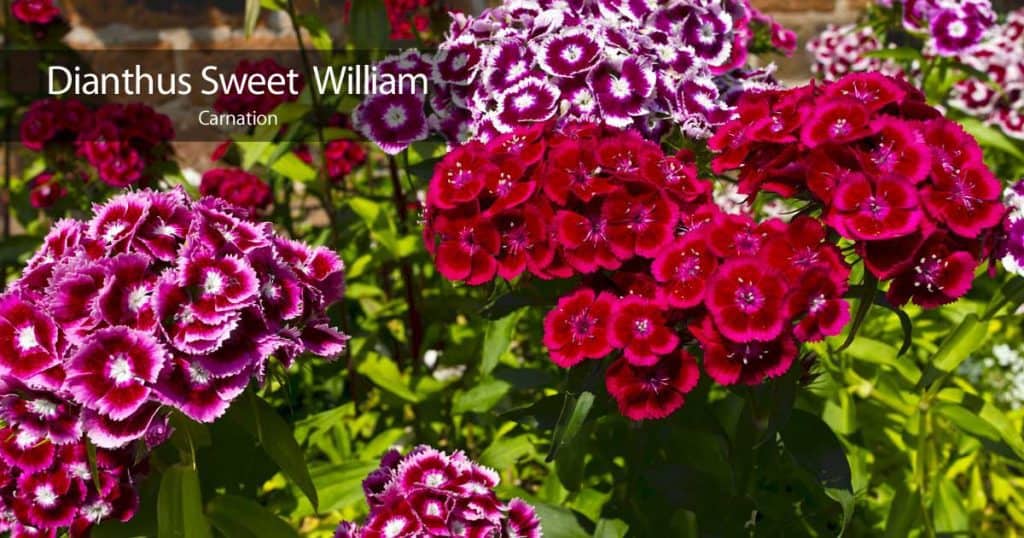 There are many kinds of Pinks, including the well-known Carnation, but most are perennial. The perennial forms, unlike the annuals, are mostly fragrant.
There are many kinds of Pinks, including the well-known Carnation, but most are perennial. The perennial forms, unlike the annuals, are mostly fragrant.
The botanical name (for both annual and perennials), Dianthus, was conferred by the ancient Greeks who named the flower after the goddess, Diana.
Pinks grow to a height of 10” to 15” inches and are exceedingly variable, producing flowers of differing forms and colors 1” to 2” inches across.
Although there are some plain colors, many are blotched, edged, or eyed with contrasting colors.
Pinks are ideal for bright-colored edgings, as mass colors in formal beds, for rock garden use and for indoor bouquets.
Pinks should be planted eight inches apart in the open ground or sown in flats in early Spring. The seeds require 6 to 10 days for germination and the plants bloom about 3 months thereafter.
Pinks thrive in any soil, except acid, and need full sun for best growth. Annual Dianthus likes cool weather and will bloom from July till frost.
Details on Growing and Care of Sweet William Dianthus Flowers
Middle Border Annuals
Medium-sized Calendulas, Poppies and the taller varieties of the previously discussed Pinks and Phlox make attractive Middle Borders.
Calendula
This extremely hardy flower furnishes yellow and orange colors to the Winter gardens in the South and West.
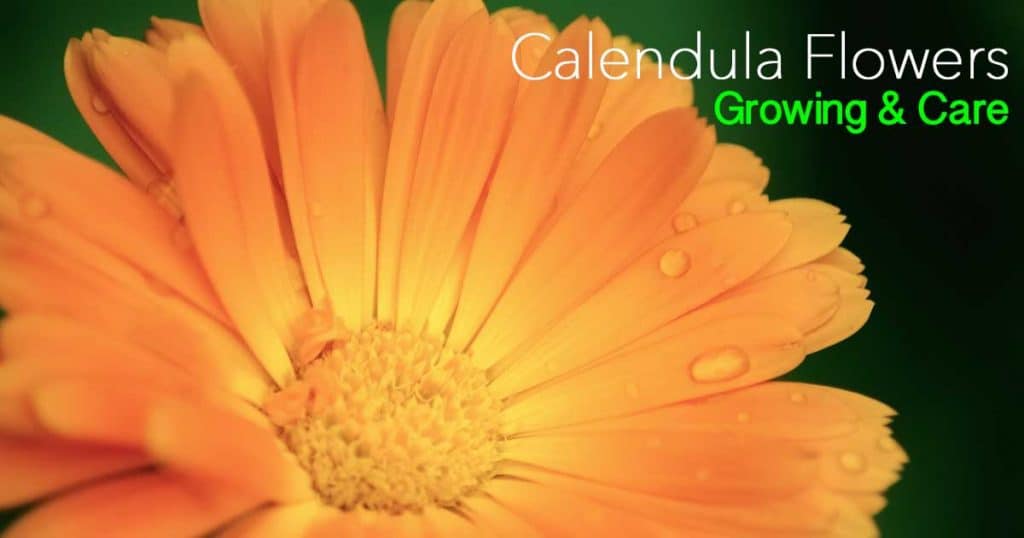 It begins to bloom early and continues until frost in Midwestern and Eastern gardens. The plants are 18” to 24” inches tall and should be thinned to 1 every 12” inches.
It begins to bloom early and continues until frost in Midwestern and Eastern gardens. The plants are 18” to 24” inches tall and should be thinned to 1 every 12” inches.
If seedlings are transplanted, they should be set apart the same distance. Early planting is essential with these cool weather beauties.
New varieties are far superior to the old-fashioned kinds in many respects.
The flowers are larger, longer-stemmed, have richer colors and are better for cutting and for garden decoration.
They are very easy to grow, but because they are planted when the ground is still cold, they develop slowly. Popular varieties are single, but doubles in all colors are available as mixtures.
Details on Growing and Care of Calendula Flowers
Poppies
Annual Poppies are found growing in the fields of Europe.
Reverend Wilkes discovered a Poppy in his garden in England with thin, white
margins on the petals, which was subsequently named “the Shirley Poppy” in
honor of the town in which he lived.
The delicate satiny petals and brilliant colors of Poppies
are duplicated by no other flower.
In addition, they have bluish- green foliage that
contrasts strikingly with the leaves of other plants. The flowers do not last
long, often fading in a single day, but one follows another in rapid succession
for several weeks.
Poppy plants are 18″ inches tall and should be planted 8″ inches apart. They come in white and shades of pink and scarlet. Seeds germinate quickly, in but 6 to 12 days, and blooms appear 60 days after planting.
Related Poppy Articles:
- California Poppy Care – Tips on growing Eschscholzia californica
- Details on growing the Iceland Poppy
- More on caring for and growing the Blue Poppy Flower
- Tips on growing the Bush Poppy
Back Border Annuals
Spire-like Larkspur and Snapdragons and clinging Sweet Pea, 3 of the most popular plants in the country, are treasured for Back Borders because of their tall size.
Larkspur (Delphinium)
Larkspur, the annual form of Delphinium, forms tall spires up to 5’ feet high.
The botanical name Delphinium means “dolphin,” which the flower resembles.
Englishmen, however, related the tailed flower to a bird’s spur, hence the name Larkspur.
The seed should be sown in the Fall, or as early as possible in the Spring, and flowers will appear in 2 to 3 months.
Seeds are slow to germinate, requiring 2 to 3 weeks in cool weather, and in hot weather will not come up at all. Larkspur is not easily transplanted, so it is best to plant the seed in the full sun where it will have the best chance of growth.
Seedlings should be thinned to at least 2’ feet to give them room to grow; otherwise the small wheezened specimens may be produced.
Larkspur ranks next to Snapdragon as a cut flower and is often used with Snapdragon as a Back Border.
In addition to furnishing a vertical accent, Larkspur’s finely-cut foliage gives an interesting texture to the flower border.
Snapdragons (Antirrhinum majus)
Snapdragons are native to Europe and were known by the Greeks and Romans of the ancient world.
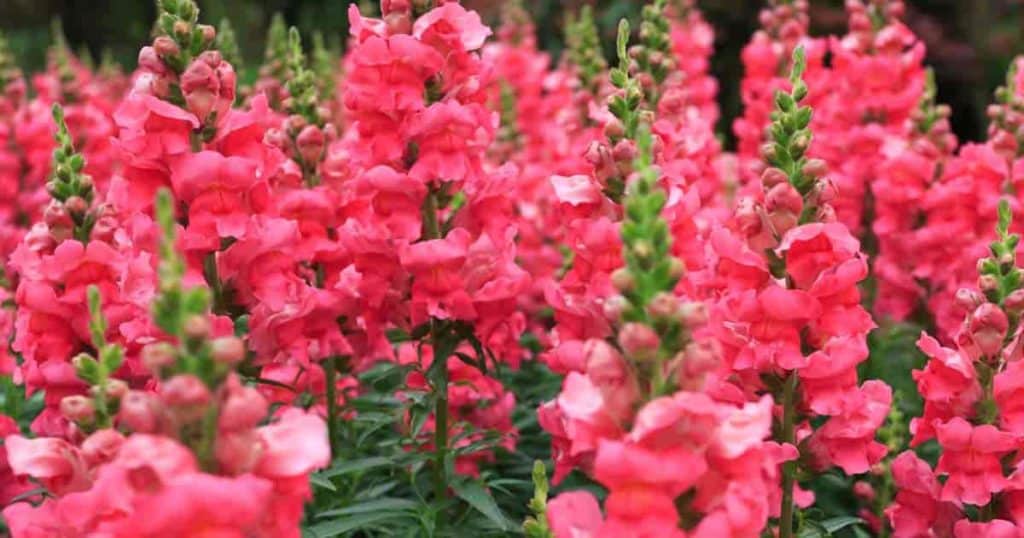 They were also grown by the earliest American colonists in pre-Revolutionary days. The original flowers were yellow, and in the early 1800s, only white and red were found listed in seed catalogs.
They were also grown by the earliest American colonists in pre-Revolutionary days. The original flowers were yellow, and in the early 1800s, only white and red were found listed in seed catalogs.
About 1850, the Snapdragon was raised to a high standard of perfection by hybridists.
Seedsmen developed plants up to 7’ feet tall, as well as dwarf strains only 6” to 9” inches tall were popular for bedding use.
Over the last 60 years, there have been numerous developments resulting in tremendous progress.
In June 1940, a cross was made between the old German maximum strain and a dwarf variety from England called En Garde. Years later, this resulted in a series of spectacular 3’-foot tall Snapdragons for outdoor growing with the best flower retention of any “Snaps.”
Well-grown plants of this series have as many as 100 florets with up to 40 open at one time. The plants branch at the base and can be cut back for repeated and continuous bloom.
Dr. A. F. Blakeslee at Cold Spring Harbor, Long Island, discovered that Colchicine would induce plant mutations or sports.
This procedure was applied to Snapdragons, producing the giant ruffled Tetra Snapdragons, were are roughly twice the size of ordinary ones.
They came in yellow, white, crimson, pink, rose and orange-rose.
The technique first used to produce hybrid seed corn was utilized to produce Supreme hybrid double Snapdragons which had all the vigor, flower quality and rich color of a hybrid, plus the fully double flowers on long, tapering spikes.
Hybrid seed was developed by first crossing varieties with especially desirable qualities.
This results in a weakening of the plant since factors which govern growth and vigor are limited. After several generations of hybridizing, the best qualities of the 2 varieties are scientifically combined in one super plant.
Thus, two puny parents produce a giant offspring.
Snapdragons should be planted 8” to 10” inches apart. The seeds require 8 to 14 days for germination and bloom about 3 to 4 months after planting.
Where conditions are favorable, the flowers are produced for several months – until frost. Sow seed outdoors when the soil becomes warm or, for earlier bloom, plant seed indoors 6 weeks before the outdoor planting time and then transplant.
Details on Growing and Care of Snapdragon Flowers
Sweet Peas (Lathyrus odoratus)
The Sweet Pea is a native of the island of Sicily and was first described by Father Franciscus Cupani in 1697.
It was widely grown and heralded for its intense fragrance. Little progress was made in varieties until 1870 when Henry Eckford created new colors and improved the shape and substance of the flower.
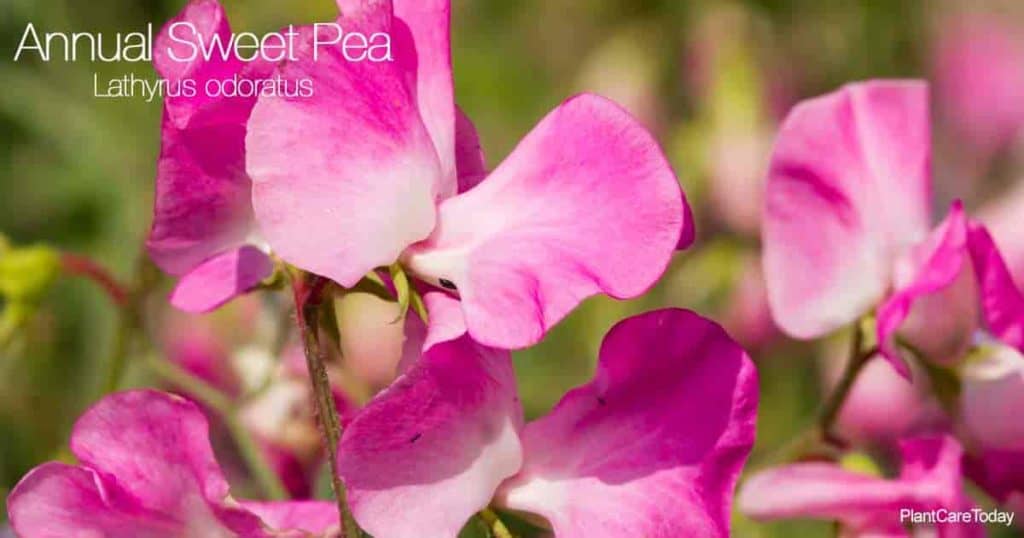 His greatest accomplishment was the increase of the number of blooms on a stem from 2 to 4. Silas Cole, the gardener to the Earl of Spencer, was the first to find a wavy-petaled Sweet Pea and named it the Lady Spencer, after his employer’s wife.
His greatest accomplishment was the increase of the number of blooms on a stem from 2 to 4. Silas Cole, the gardener to the Earl of Spencer, was the first to find a wavy-petaled Sweet Pea and named it the Lady Spencer, after his employer’s wife.
In the 1890s Sweet Peas became tremendously popular and in England, where Sweet Peas have a long season, it was the standard flower for weddings and table decorations.
Sweet Pea (Lathyrus odoratus) was well on its way to becoming the most popular annual in America when the dread near-wilt disease struck and spread swiftly around the country.
This disease is more severe when it is warm and it was finally conquered with the advent of heat-resistant strains.
There are several kinds of Sweet Peas. The original Spencers improved by the selection of early-flowering strains which bloomed 3 to 4 weeks earlier than the standard. They were planted in August to get Sweet Peas by Christmas in the warm Winter areas.
Later more heat-resistant varieties arrived which were planted in October in warm Winter areas and in Spring in cold areas.
Next came Galaxy Sweet Pea with large clusters of 5 to 7 flowers, many of which opened at the same time.
This series started blooming in early Spring and continued throughout the Summer where conditions were favorable.
Sweet Peas grow on a vine that clings by means of tendrils.
Supports should be provided and seedlings thinned to 2” inches apart when they emerge and, ultimately, to 4” inches when they begin to twine.
They are extremely hardy and may be planted in the Fall, even in the coldest winter areas.
If seeds are not planted in the Fall, they should be planted in earliest Spring.
You don’t even have to wait until all of the frost is out of the ground. The seeds take from 2 to 4 weeks to germinate, but the earliest bloom about 2 months after planting. It is best not to transplant Sweet Peas.
- Details on Growing and Care of annual Sweet Pea
- Details on growing the Perennial Sweet Pea
Miscellaneous Annuals
The plants covered in this section come in a variety of sizes. Thus, the smaller ones are used in Edging, but the taller varieties are more suited for Middle and Back Borders.
Candytuft (Iberis)
Candytuft, a native of Crete, has 3 basic forms:
- The giant form (18” to 24” inches tall)
- Umbellata (9” to 12” inches tall)
- Dwarf type only growing to 6” inches
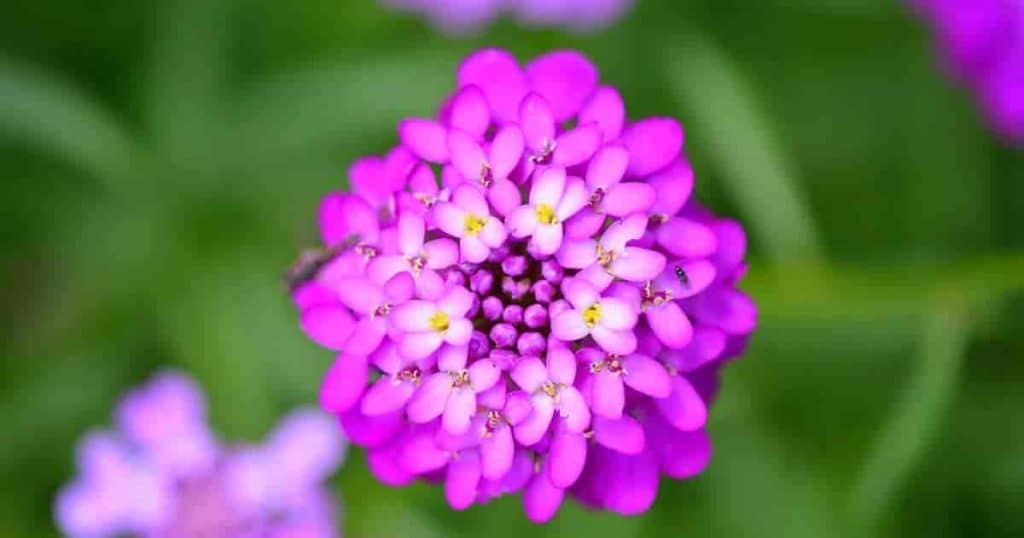 This sweet-scented plant is very hardy and can be sown in the Fall in mild areas and in early Spring in colder regions.
This sweet-scented plant is very hardy and can be sown in the Fall in mild areas and in early Spring in colder regions.
Candytuft flowers 40 to 50 days after planting and blooms for about 2 months. The medium-sized plants should be spaced 4” inches apart, with the other sizes spaced accordingly.
Originally white, different varieties of Candytuft now produce pink, rose, carmine, crimson, lavender and white flowers.
Details on growing and care of Candytuft – Iberis Umbellata
Baby Blue Eyes (Nemophila)
Baby Blue Eyes (Nemophila) is a California native and a garden favorite all over the world.
The plants are 8” to 12” inches tall and have a deep blue, cup-shaped flower produced on sprawling stems against a background of soft, feathery foliage.
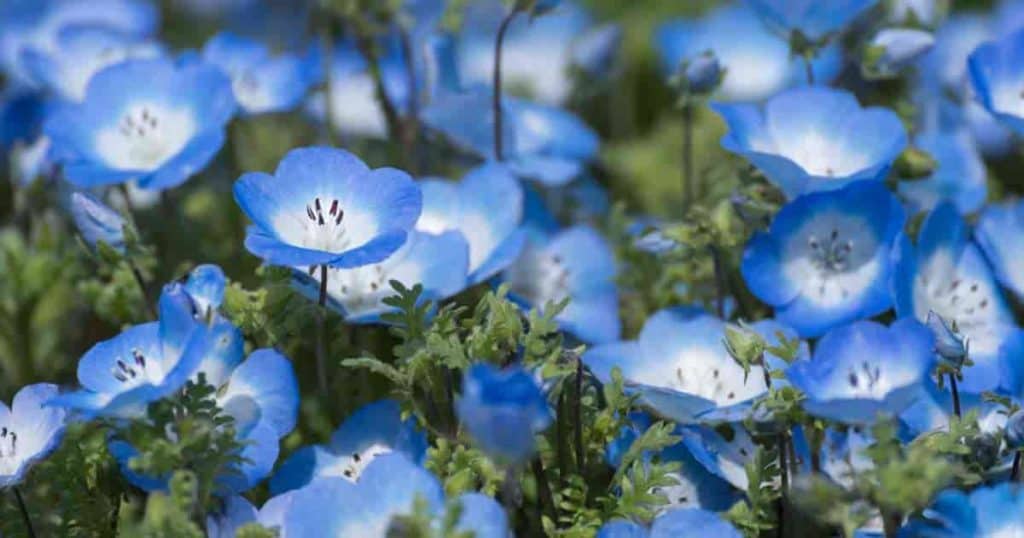 It is one of the earliest annuals to bloom and one of the easiest to grow. It blooms heavily in poor soil.
It is one of the earliest annuals to bloom and one of the easiest to grow. It blooms heavily in poor soil.
Seed should be planted thickly in very early Spring or in the Fall. In light shade, the plants bloom longer. Plants begin to bloom in February in most areas, but in the North, seeds planted in May bloom from July to frost.
It is a good choice for hanging baskets in the shade and for containers in the shady patio. It makes a contrasting blue carpet under Daffodils and is a good ground cover for Tulips.
Details on growing and care of Baby Blue Eyes Flower – Nemophila
Clarkia
Clarkia, a native of the Western United States, was named in honor of William Clark of the Lewis and Clark Expedition.
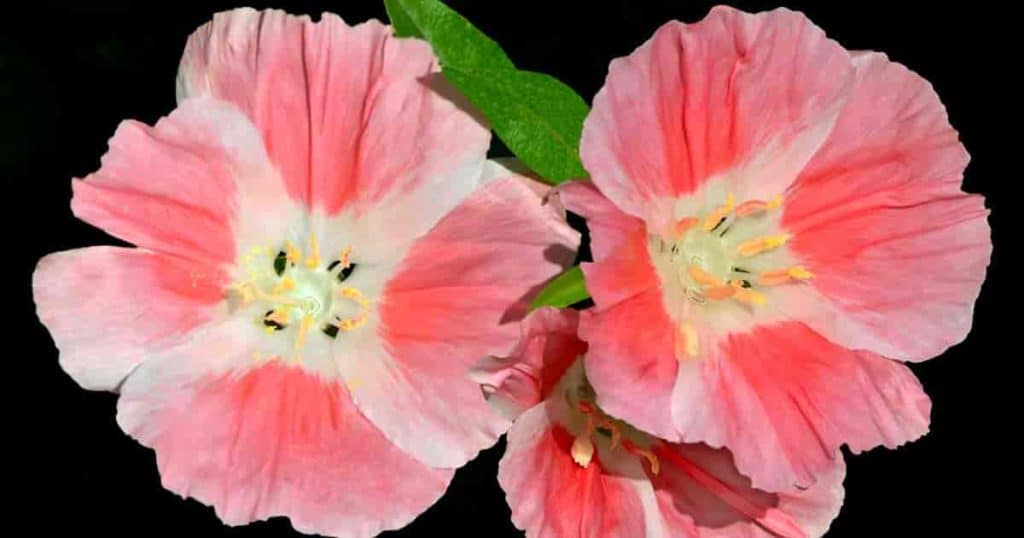 It should be sown thickly in the Fall or early Spring where the plants are to grow, and will naturalize easily in most areas.
It should be sown thickly in the Fall or early Spring where the plants are to grow, and will naturalize easily in most areas.
The plant has slender, reddish stems, sparse foliage composed of small, narrow, green leaves and medium-sized double flowers which appear at every joint.
The carnation-like flowers come in shades of rose, lilac, pink and white, and will continue until frost in areas where the summers are cool.
Details on caring for and growing Clarkia Flowers
Baby’s Breath (Gypsophila)
Less commonly known than the perennial variety (Gypsophila Paniculata), annual Baby’s Breath Gypsophila muralis can be sown any time from early Spring until July.
Since the blooms, which appear in only 5 to 6 weeks, continue for only 2 to 3 weeks, successive plantings should be made for more continuous flowering.
The plants of this hardy species attain a height of ½” to 2’ feet.
Bachelor Button (Centaurea Flowers)
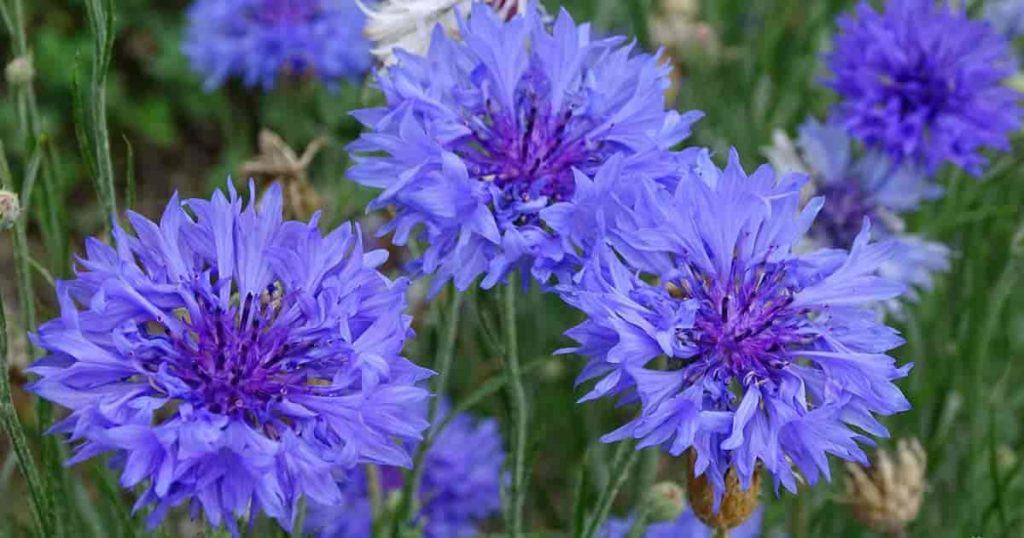 Plant seeds in Spring or Fall and thin plants 4” to 6” inches apart.
Plant seeds in Spring or Fall and thin plants 4” to 6” inches apart.
Bachelor Button grows best in cool weather and dies out in heat. The blue variety was a favorite for cutting and boutonnieres.
Details on care and Growing Bachelor Buttons
Rudbeckia
Gloriosa Daisy is the name of a Giant tetraploid created by Dr. A. F. Blakeslee.
Although it is a perennial, it is treated as an annual because the plants flower the first season if the seed is sown early.
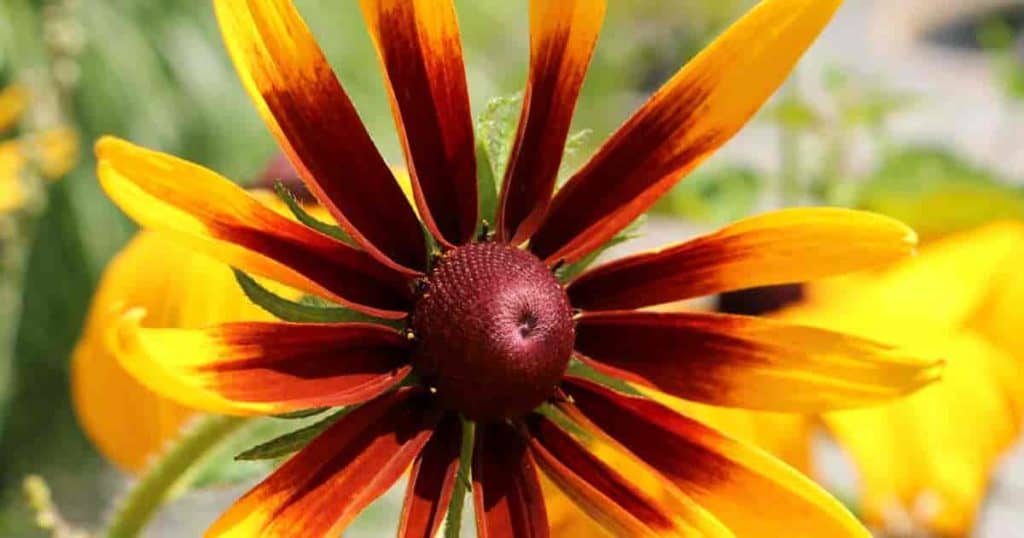 However, the best time for planting is probably in August. Rudbeckia hirta lives throughout the Winter, even if the weather falls below zero.
However, the best time for planting is probably in August. Rudbeckia hirta lives throughout the Winter, even if the weather falls below zero.
The Double Gloriosa Daisy was a 1961 All America selection. Plants are 3’ feet high with spectacular blooms averaging 5” inches across.
The seed comes up quickly and seed started indoors in February or March will bloom in Summer. Flowers last till frost.
Details on caring for and growing Gloriosa Daisy Flower
Stock (Matthiola)
Matthiola is a beautiful fragrant flower widely grown for the florist trade in California.
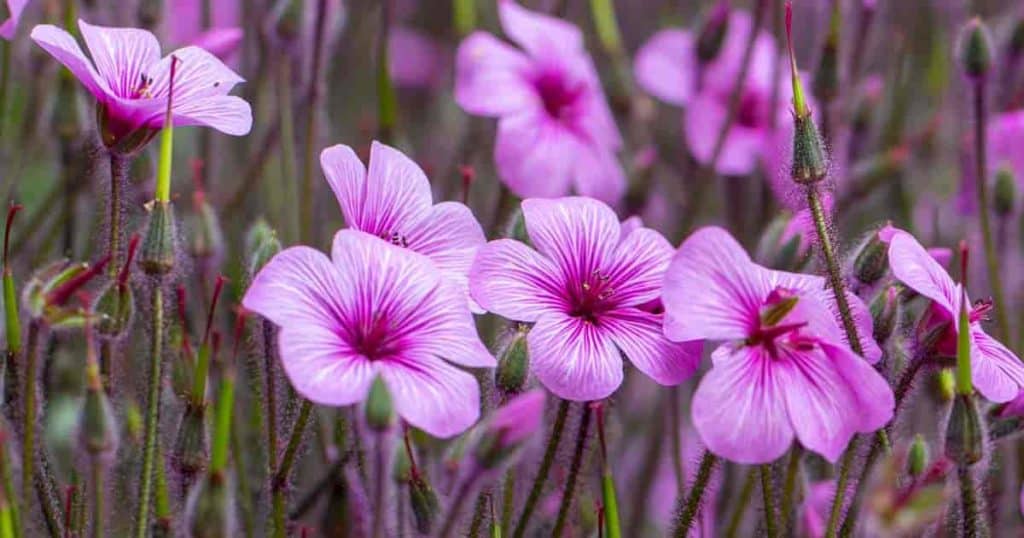 It is not easily grown in the rest of the country because it demands cool weather.
It is not easily grown in the rest of the country because it demands cool weather.
The seed should be sown indoors in March and transplanted to the garden in May.
Stock is available in separate colors (including pink, rose, lavender, purple and dark red), blooms 65 days after the seed is planted.
Details on growing and care of Stocks Plants
Cineraria
Cineraria is so hard to grow in the garden that it is mostly sold at garden centers in full bloom.
In addition, seeds are extremely costly and difficult to handle outside of a greenhouse.
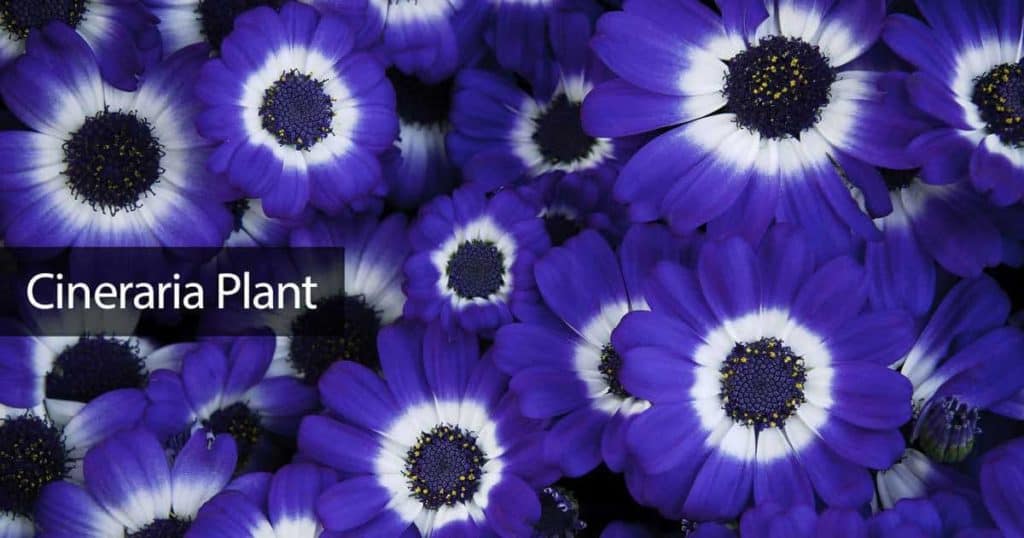 However, young plants can be obtained for setting out in the garden.
However, young plants can be obtained for setting out in the garden.
Plant Cineraria in the shade, keep them constantly moist and protect them against slugs, snails and leaf miner.
Clusters of 3” to 5” inch Daisy-like flowers in vivid shades of pink, lavender, blue, purple and white appear in late Winter in mild climates and in Spring and early Summer elsewhere.
Plants grow about 1’ foot in height.
Details on growing and care of the Cineraria Plant















